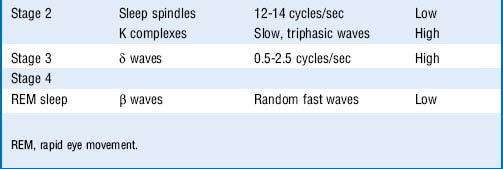Chapter 24 Behavioral Sciences
2 In addition to a diagnosis of adjustment disorder with depressed mood, what sleep-related disorder likely explains most of this patient’s problem?
3 What treatment can be employed to allow this man to sleep at night?
 Obstructive sleep apnea may be associated with loud snoring, difficulty concentrating, poor memory, and waking up feeling unrested after sleep.
Obstructive sleep apnea may be associated with loud snoring, difficulty concentrating, poor memory, and waking up feeling unrested after sleep.
 Sleep studies will show apneic episodes, frequent arousals, and decreased rapid eye movement (REM) sleep.
Sleep studies will show apneic episodes, frequent arousals, and decreased rapid eye movement (REM) sleep.
 Depending on the case, treatment may consist of lifestyle modifications and nasal continuous positive airway pressure (CPAP).
Depending on the case, treatment may consist of lifestyle modifications and nasal continuous positive airway pressure (CPAP).
2 What is the likely diagnosis and what would be the expected electroencephalographic findings?
Note: Patients with primary hypersomnia have a completely normal sleep architecture.
5 In Table 24-1, cover the columns to the right, and for each stage of sleep listed in the left column, name the EEG appearance and describe the frequency and voltage of the waves seen:
7 An 82-year-old woman complains that her sleep patterns have changed as she has aged. What changes in sleep are typical as people age?
8 This woman had been given a benzodiazepine to assist her sleep, which improved for a while, but now she complains of poor sleep once more. Why have her sleep problems returned?
11 There are now a number of drugs other than benzodiazopines that also act on the γ-aminobutyric acid benzodiazepine receptor and that reach hypnotic effects with less tolerance and less daytime sedation. What are some examples of these?
Zaleplon, zolpidem, and eszopiclone are examples of these drugs.
12 When evaluating a person for sleep problems, perhaps the first and most important step is to make sure that the patient has good sleep hygiene. What does good sleep hygiene entail?
 Regular exercise (but not too late in the day)
Regular exercise (but not too late in the day)
 Relaxing activity before bed (e.g., bath, reading)
Relaxing activity before bed (e.g., bath, reading)
 Only sleep and sex in the bedroom (no TV)
Only sleep and sex in the bedroom (no TV)
Summary Box: Sleep Disturbance
 Narcolepsy: daytime sleepiness, sleep attacks, decreased rapid eye movement (REM) latency, rested after sleep
Narcolepsy: daytime sleepiness, sleep attacks, decreased rapid eye movement (REM) latency, rested after sleep
 Primary hypersomnia: excessive somnolence (>1 month), normal sleep architecture
Primary hypersomnia: excessive somnolence (>1 month), normal sleep architecture
 Treatment for narcolepsy and primary hypersomnia: methylphenidate or modafinil
Treatment for narcolepsy and primary hypersomnia: methylphenidate or modafinil
 Insomnia: difficulty initiating or maintaining sleep
Insomnia: difficulty initiating or maintaining sleep
 Nonbenzodiazopines acting at the benzodiazepine γ-aminobutyric acid (GABA) receptor may be the best treatment for insomnia because they allow for hypnotic effects with less tolerance and less daytime sedation.
Nonbenzodiazopines acting at the benzodiazepine γ-aminobutyric acid (GABA) receptor may be the best treatment for insomnia because they allow for hypnotic effects with less tolerance and less daytime sedation.
Stay updated, free articles. Join our Telegram channel

Full access? Get Clinical Tree









